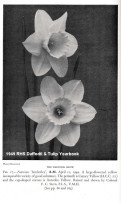Sir Colonel Frederick Stern
d 1967. Goring-by-Sea, Sussex, England. Knighted 1956
Sir Colonel Frederick SternPercival D. Williams, England
Year Registered: 1927
Merit

Percival D. Williams, England
Year Registered: 1927

Fl. 117 mm wide; perianth segments broadly ovate, blunt, vivid yellow, with slight white mucro, spreading, smooth, with midrib showing, overlapping one-third; the inner segments more narrowly ovate, somewhat twisted or with margins incurving; corona funnel-shaped, lightly ribbed, slightly darker in tone than the perianth, with mouth straight and 6-lobed, lightly frilled, rim crenate.
A description from the 1954 Swais of Bristol catalog: “A large, uniformly rather soft golden-yellow flower with very smooth, broad, overlapping perianth segments, and a well-proportioned bowl-shaped cup. The color is most pleasing. Raised at Highdown, on Sussex chalk, this variety does not demand the lush conditions required before so many modern Daffodils will show their best, and its value for most gardens is accordingly enhanced. Best flower in competitive classes R.H.S. April, 1948.”
The daffodil was named after a World War II airfield. Amberley was given to the area by Mr James Edwin Collett, a farmer who arrived from Sussex England in the 1850’s to settle on a property at 3 Mile Creek west of Ipswich. He went by the name Edwin Collett. He called the property “Amberley” after his home town of “Amberley” a small village on the River Aron in East Sussex. James Edwin Collett and many of his family and relatives are buried just off the Air Force base in a local cemetery.
 Amberley, 2 Y-Y, Sir Colonel Frederick Stern, England, 1944
Amberley, 2 Y-Y, Sir Colonel Frederick Stern, England, 1944
Photo #31397 RHS Yearbook, England Amberley, 2 Y-Y, Sir Colonel Frederick Stern, England, 1944
Amberley, 2 Y-Y, Sir Colonel Frederick Stern, England, 1944
Photo #31313 RHS Yearbook, England
![]()
